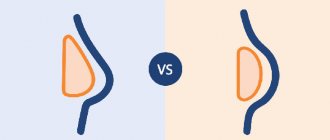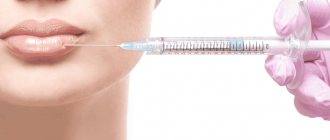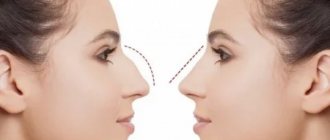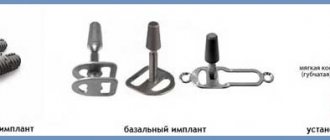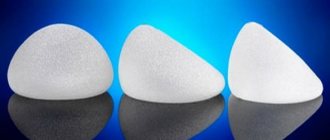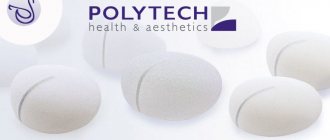The main emphasis is on breast implants filled with cohesive silicone gel. Their benefits have been appreciated by hundreds of plastic surgeons and thousands of grateful patients. POLYTECH silicone breast implants have optimal physical properties and meet all the requirements of modern plastic surgery. The highest quality of products is achieved through strict control at each stage of implant manufacturing - the enterprise’s structural divisions engaged in research and development are located in the same city.
Types of Polytech breast implants
The manufacturer offers a wide selection of breast implants of different sizes, shapes and profiles. In addition, an important factor is the choice of surface of the product.
The shape of implants can be round or anatomical. The possibility of individual selection of anatomical shape is achieved by the fact that products of this type are produced with different base options: round, shortened and oblong.
There are also 4 profile options for Polytech implants: low, medium, high and extra high. The profile determines the degree of breast height after surgery.
The product shell can be:
- Smooth or micro-textured (MESMO® sensitive™).
- Macro-textured (POLYtxt®).
- Micropolyurethane (Microthane®)
The Microthane® polyurethane foam surface was designed specifically to minimize the risk of implant displacement or rotation. In addition, the use of this type of shell ensures the prevention of such postoperative complications as capsular contracture.
In total, the model range is represented by more than 200 options, so that for each woman the type of product that is most suitable for her is selected. If necessary, implants can be made to order, taking into account all individual characteristics.
The following approaches for breast augmentation with implants are distinguished:
- Through submammary access (in the fold under the breast);
- Through periareolar access (along the areola of the nipple);
- Endoscopic magnification method (using axillary access);
- Operation in 2 stages using expander dermatense;
- A method of breast enlargement through the navel.
The right to choose access during surgery belongs to the patient herself.
. The surgeon’s words are advisory in nature, because with a small areola or the presence of large ptosis, the choice of implant changes. There is also no point in installing an implant through an incision under the breast if there is no fold there. All scars must be hidden. Therefore, if it is possible to install an implant through the axillary approach, then this access is usually used. For axillary access, it does not matter whether the implant is installed before or after childbirth. There are some restrictions for access through the areola, but with current technologies for installing implants, breast tissue is practically not injured.
Security guarantees
POLYTECH Health & Aesthetics is ISO 9001 and ISO 13485 certified, reflecting the quality and integrity of its operations. All products are also certified and CE marked (meets European Union standards). The manufacturer provides a lifetime warranty, which ensures free replacement of the implant in case of displacement or rupture of the shell.
Each of the products undergoes a thorough sterilization stage, due to which the percentage of infectious complications is practically reduced to zero. The reliability of the implants was confirmed by numerous tests on the tensile strength of the shell.
Thus, Polytech implants not only provide the opportunity to select the ideal breast size and shape, but the company also provides women with a high level of product quality and guarantees a minimal risk of complications.
Breast augmentation surgery techniques:
1.
With submammary access,
a 4-5 cm long incision passes along the fold under
the gland
. Using this method, the surgeon can visually monitor the progress of the operation, which is why it is traditionally considered the safest and most popular among patients. Over time, breasts enlarged in this way will droop slightly, take on a more natural shape and hide the incision in the crease under the breast. The scar fades over time and turns into a thin white line. Although, it should be noted that this access is problematic for thin girls with micromastia (very small breasts), since the scar will be quite noticeable. This approach is considered traditional for augmentation mammoplasty.
2. For periareolar type
access, the incision is located around the areola of the nipple or along the lower part of the areola like an arc. This method is usually not recommended for women who are planning pregnancy and breastfeeding in the future, since the periareolar approach compromises the integrity of the mammary gland, even though the surgeon tries to push the gland as gently as possible in a blunt manner. The advantage of this method is that the traces of surgical intervention in this case are almost invisible and are located along the edge of the areola (nipple). After the scar has formed, you can tattoo the areolas. In the practice of plastic surgery on the breast, the peripapillary approach is mostly used, that is, access along the areola, but the most interesting method is the axillary access. This is a very interesting technique because during its implementation, endoscopic equipment is used to visualize the vessels and pouch. This is a technically beautiful operation. For the patient, this is also a plus, since the scar is hidden in the armpit and when the implant is installed under the muscle, it does not come into contact with the breast tissue and does not contour.
3. Endoscopic breast augmentation method
is the most complex and high-tech. The operation in this case is carried out using expensive endoscopic equipment, which visualizes the vessels and nerves during implant installation, and allows them not to violate their integrity. In this case, a 3-4 cm incision is made in the axillary region and the scar remains almost invisible, fades over time, and disappears into the natural folds of the armpit. This access is traditionally recommended for women planning pregnancy and breastfeeding in the future, since the integrity of the mammary gland is not compromised and the implant installed under the pectoralis major muscle does not come into contact with the gland. The disadvantage of the method is the relatively “long path” of endoprostheses to the mammary glands, as well as the limitation of the volume of the implant - no more than 400 ml. If the patient wishes to install prostheses larger than 400 ml, then the operation is performed either through the areola of the nipple, or in the fold under the breast, or in two stages - using the expander dermatension method.
Separately, it is worth mentioning the postoperative period after installation of the implant through the axillary access
. It is important in order to prevent displacement of the endoprosthesis. Therefore, it is imperative to wear compression garments for at least 1 month after surgery and limit the mobility of this area. Everything else can only be attributed to the advantages of this method. Scars in the armpits are not noticeable, as they are located in the natural folds of the skin, and besides, this area is not so often visible.
Read more about endoscopic breast augmentation through the armpit >>
4.
Augmentation mammoplasty using
expander dermatension
is performed if the volume of installed (desired) implants is sufficiently large, and there is a lack of native tissue in the breast area. This method of breast enlargement involves installing an expander for a period of up to 1.5-2 months, which gradually, delicately stretches the breast tissue. The expander looks like breast implants. When the necessary stretching has occurred, the desired size of endoprostheses is installed using any of the above approaches. The operation thus takes place in two stages. Pain syndrome in the postoperative period is low due to the fact that the tissues are “ready”. This method can also be used to correct obvious asymmetries.
5.
Previously,
endoscopic access through the navel
, but now the method is not used due to the distance of the access point from the mammary glands and the impossibility of high-quality formation of a pocket, as well as frequent cases of “leaking” of the prosthesis. When accessing through the navel, it is very difficult to install a reliable silicone endoprosthesis, so surgeons used shell prostheses, which were filled with a liquid such as saline solution at the end of the surgical intervention. The described method is rather scientific in nature.
Installation under the gland or under the muscle?
The choice of installing an implant under the gland or under the muscle depends on
constitution and the presence of soft integumentary tissues in the patient. If they are not there, then of course, the deeper we “hide” the endoprosthesis, the less likely there will be contouring. If your own tissues are good, there are many of them, then you can install an implant under the gland. That is, in other words, the choice depends on the integumentary tissues, body type, taking into account such indicators as height, weight, chest width, torso length, etc.
